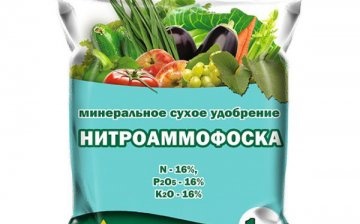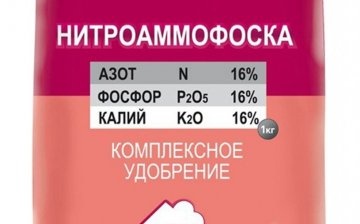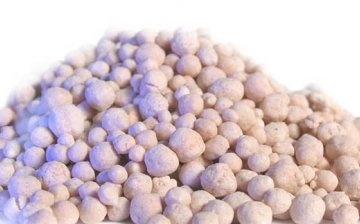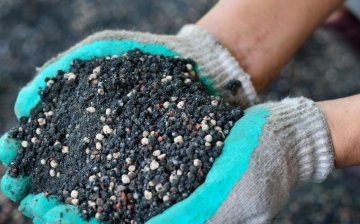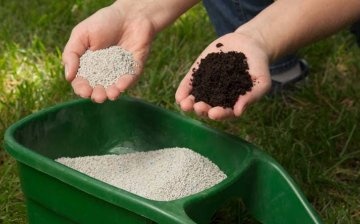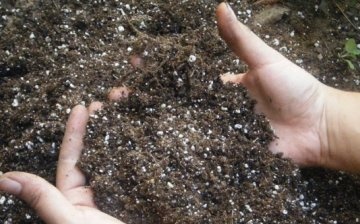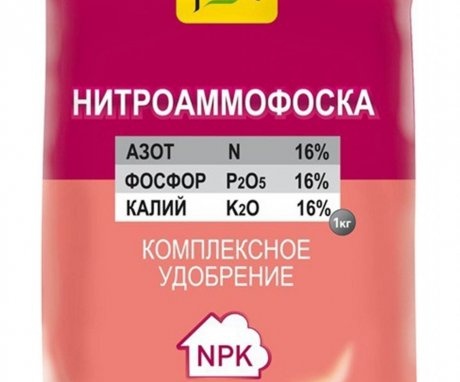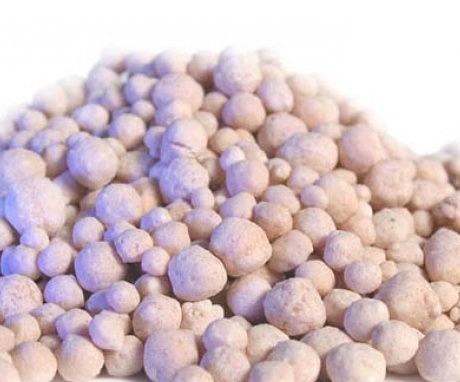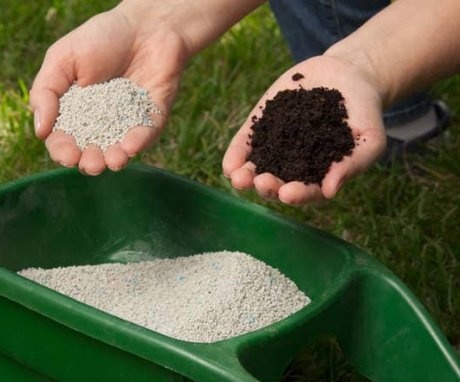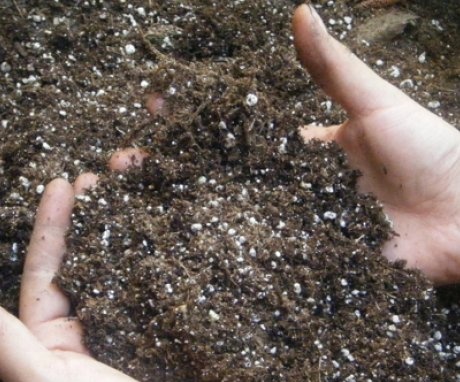Nitroammofosk: composition and application
In the modern world, it is not always possible to find enough time to recharge the soil in natural ways. And also not everyone has enough space for this. Therefore, various balanced dressings have been developed, among which nitroammophoska is especially popular.
Content:
- Composition and types of Nitroammofoska
- Advantages and disadvantages of fertilization
- Application rules and norms
- Features of the application of Nitroammofoska for different cultures
Composition and types of Nitroammofoska
Nitroammofosk is a universal complex fertilizer that combines minerals and such important macronutrients as nitrogen, phosphorus and potassium, which are necessary for the nutrition and good development of any crops. The complex of basic substances is indicated on the package with the abbreviation NPK and the proportional ratio of these substances in the composition. In addition to the main elements, the composition may contain a set of salts, represented by ammonium chloride, nitrate and superphosphate or calcium chloride and principitate.
The form of fertilizer release is pale pink granules that dissolve well in water.
To prevent the granules from sticking together, dry gypsum is added to the fertilizer package. Several brands of fertilizer have been developed, which differ in different amounts of basic elements. This allows you to select the right proportions of macronutrients for different plants.
According to its composition, it is customary to divide nitroammofosk into several groups:
- enriched with sulfuric acid, which has proven itself in the cultivation of legumes, because sulfur elements stimulate the formation of plant proteins
- with a high sulfate content - used for flowering and deciduous flowers. Calcium has a positive effect on the color saturation of flowers and foliage
- the predominance of phosphorus compounds increases the yield of tomatoes and other nightshades, and also contributes to their better keeping quality
The main value of nitroammofoska for gardeners is that there are no nitrate impurities in the composition. This makes the fertilized vegetables and fruits completely safe and healthy.
On store shelves, you can also find fertilizers called Nitrofoska, Azofoska, Ammofoska or Nitroammophos. In fact, this is the same top dressing, only the ratio of the active elements in them is different:
- Azofoska is an analogue of nitroammofoska. But in addition to the main elements, it also contains sulfur. The impact on cultures is virtually no different. Phosphorus is found entirely in a soluble form. Application is possible both for planting and basic fertilization, as well as for dressing in the off-season.
- Nitrofoska is complex mineral fertilizer, which has the same composition as Nitroammofosk, but is also enriched with magnesium. The composition of the fertilizer includes ammonium nitrate and concentrated phosphorus, as well as additives of ammonium phosphate and potassium chloride. The nitrogen content is provided in the form of nitrate, which is why it is quickly washed out of the soil. Thanks to this, fertilizer can be applied even during the flowering period.
- Ammofoska - a concentrated three-element top dressing containing sulfur (about 14%) and magnesium.The composition does not contain chlorine and sodium, the minimum amount of neutral impurities. The composition is easily diluted with water, so it is safe to use it even in greenhouse conditions. Gives a good effect when applied to sandy and clay soils.
- Nitroammophos - contains equal amounts of phosphorus and nitrogen, and also has balanced additions of ammonium nitrate and phosphate. Has good water solubility. It is actively used for fertilizing agricultural plantings in the main and preparatory period.
Nitroammofosk belongs to moderately hazardous substances and belongs to the third hazard class. It has a long shelf life and does not lose its useful properties for six months.
Advantages and disadvantages of fertilization
Despite the declared safety of Nitroammofoska, when using this fertilizer, it should be borne in mind that this is a chemically created substance and therefore it has a set of advantages and disadvantages.
The benefits are:
- in ease of storage and transportation
- in each granule the right proportions of macronutrients are balanced
- in ease of use, because the dressing is perfectly soluble in water and can be applied both in liquid and dry form
- in the ability to increase the yield of vegetable and fruit crops by 35-75%
The disadvantages are the inorganic composition, which increases the risk of nitrate concentration in the soil. And also the substance is quite flammable, so it should be protected from direct sunlight and open sources of fire.
And also it should be remembered that improper use of this fertilizer can destroy all the efforts put on growing plants and cause significant damage to the composition of the soil.
Application rules and norms
It is permissible to use Nitroammofosk in the form of a solution or granules, which are simply embedded in the ground. The presence of instructions will allow you to determine which method of introduction is suitable for a particular situation. The manufacturer is obliged to prescribe the required dosage and application rates for specific crops.
For example, for fertilization beets you need to take from one hundred to two hundred kilograms per hectare of area. 16-22 grams per square of soil is enough for potatoes, up to 50 grams are applied under the berries, and up to half a kilogram of the substance under each fruit tree. To prepare a solution, 20 grams of nitroammophoska is dissolved in 10 liters of water. But when using this fertilizer, it must be remembered that its lack leads to a decrease in the quantity and quality of the crop, and also slows down its ripening. If you allow an overkill in fertilizer, then you can completely lose the crop.
The necessary norms are calculated based on the composition of the soil and the needs of specific crops, therefore, you must strictly follow the instructions.
Experts have developed some recommendations that can be followed when working with a nitroammophos:
To prepare the soil for one hectare of usable area, you should make:
- under corn - up to 200 kg of fertilizer
- under rice - up to one hundred kilograms
- for sunflower you need 220-360 kg
- for cereals - from 100 to 500 kg
For root dressing:
- vegetable seedlings and potatoes should be given 15-22 grams per square meter of area
- strawberries and blackberry it will take from 30 to 50 grams per one running meter
- fruit and berry plants need from 80 to 500 grams for each unit
Nitroammophoska is simply indispensable for cultivation grapesbecause this culture actively consumes all three basic elements. Also, the use of such fertilizer can reduce the incidence of scab plants, powdery mildew, black leg and keel. Experts recommend feeding twice a season. For the first stage, a fertilizer is selected with an equal ratio of all elements, and for the second - with a reduced nitrogen content for horticultural crops and with an increased one for flowering and deciduous.
Features of the application of Nitroammophoska for different cultures
It is difficult to give a general scheme for introducing nitroammophoska for different crops, because they need a different number of basic elements:
- For potatoes... It is convenient to apply nitroammophoska over large areas, adhering to the rate specified in the instructions. But many gardeners practice feeding during planting, adding about 1 tbsp to each planting hole. l. feeding interspersed with bone meal. The best results can be achieved by fertilizing the soil in advance. Manipulations are carried out in late autumn when digging a site. Re-enrichment of the soil is carried out in the spring, shortly before planting. It should not be forgotten that potatoes should be given an increased percentage of potassium, so the choice of the type of feeding should be correct.
- For tomato and cucumbers... It should be remembered here that tomatoes need a higher phosphorus content, but it is better to give cucumbers an equal amount of macronutrients. It is on this that the choice of the brand of nitroammophoska should be oriented. The peculiarities of fertilizing tomatoes is that a granular substance must be added to the seedlings, mixing it with the ground when planting. And the secondary subcortex is carried out at the time of budding through a fertilizer solution. Cucumbers are fed according to the same principle, only the application rates are slightly lower.
- For flowering and decorative deciduous plants. For these purposes, the sulfate brand of Nitroammofoski is chosen. Its popularity is due to the fact that the introduction is possible at any time of growth and development, which cannot be said about organics. The main thing to remember is that nitrogen stimulates the growth of greenery, so this element should be limited during the flowering period. But if the main goal is decorative gardening, then nitrogen will give the garden lush and rich greenery.
More information can be found in the video:
Nitroammofoska, as a fertilizer, is invaluable both for harvesting and for decorating a garden plot. But since this is a substance of the third hazard class, you should work with it with extreme caution. Hands must be protected with gloves, observe the application rates prescribed in the instructions. The substance should not be heated, but it should be stored out of the reach of children and animals.
Competent selection of the type of Nitroammofoska contributes to the intensive development of plants during the growing season, the formation of large attractive fruits, an increase in shelf life, and also increases resistance to diseases and pests. But do not forget that the substance is not organic and was created on the basis of chemicals, so you should not overdo it with its use and alternate feeding with organic matter.



